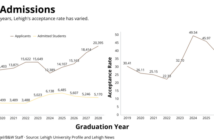
Micah Golomb-Leavitt
Within 10 minutes of getting my first iPhone, I created a Snapchat and connected my Facebook and Twitter accounts. I finally felt connected to the world.
I imagine I was not the only teenager who took these actions after getting what felt like the best present ever.
Consuming social media has become young adults’ favorite pastime — scrolling through Instagram feeds, watching Facebook’s cooking videos and reading President Trump’s all-caps tweets. These applications are easy procrastination tools that can fit in your pocket. Why wouldn’t we abuse that power?
The term “social media” was coined in the mid-’90s, referring to the mashup of technology and communication. The rush of social networks began to swarm the world like angry bees. As a result, we now live in a world dominated by instant messages, posts, comments and likes.
But social media is not simply a time consumer. With their incredibly sophisticated technology, giants like Facebook and Snapchat have become our means to communicate with each other and make plans. Rather than meeting up and talking, we text. Rather than telling our friends about a sunset we saw, we take a picture and post it to Instagram.
Bringing the social scene online comes with its consequences.
Anxiety among young adults increases as a result of spikes in social media use, according to a study done by Michigan State University. The study relied on the diagnosis of anxiety based on self-reported answers to the following questions: “Are you nervous around other people?” and “Do you avoid social situations?”
I’m aware of social media’s effects on my ability to control social situations, yet I still insist on catering to these habits. I’m not going to stop using Instagram even though I know pictures on my feed are glorified and exaggerated.
If I get to a class early, I look at my phone before the professor starts talking. After class ends, I feel compelled to check my missed notifications.
When in doubt, look at your phone. This tendency limits human interaction and discourages people from stepping outside their comfort zone because it has become more comfortable to speak to others through social media rather than in person.
Connection through social media has become so important that Lehigh has developed its own guidelines for social media use among university employees. The rules encourage workers to be respectful and to keep the university out of all posts, stressing confidentiality.
The university realizes the addiction to social media and is aware current and prospective students are watching news feeds meticulously. Lehigh acknowledges the risk in social media as the basis for rumors to spread about the university, and its strict guidelines for professionalism on sites like Facebook and Twitter reflect that.
According to a research study by Small Business Trends, 39 percent of social media users look at sites like Facebook and Instagram in order to “kill time.” The study further concluded that one in every three minutes spent online is on a social media site, totaling an average of about two hours a day.
That’s two hours a day of looking at a screen, watching mindless videos and connecting with friends and family through images and messages. But ironically, students at Lehigh and others alike are learning from social media.
We can now get news on Snapchat in an aesthetically pleasing way by tapping a finger on the screen and engaging with different visual displays from CNN, ESPN and other platforms.
Young adults are also adapting simultaneously with technology, as students in college right now are more tech savvy and social media savvy.
So while we might make less eye contact and avoid stepping out of our comfort zones in unfamiliar social settings, we are learning as a result of our online habits.
Can the cause of the social media epidemic be traced back to the users or to the creators? Those responsible for creating Snapchat and Twitter developed the applications with the purpose of addiction and control by sending notifications to users for irrelevant updates. On the contrary, the users are the ones who irresponsibly allow social media use — scrolling, tapping and swiping right to dominate their time.
Although social media use is undoubtedly an addiction, our society has become significantly more technologically advanced than it was before. We have created ways to connect with whomever, wherever, and we have created an entirely new source of entertainment for ourselves, despite its negative side effects.
If the question is whether or not we have progressed intellectually as a society, and a country, as a result of our social media use and abuse, I firmly believe we have.
We’re just keeping up with the times.
—
Micah Golomb-Leavitt, ’20, is an assistant lifestyle editor for The Brown and White. He can be reached at [email protected].





Comment policy
Comments posted to The Brown and White website are reviewed by a moderator before being approved. Incendiary speech or harassing language, including comments targeted at individuals, may be deemed unacceptable and not published. Spam and other soliciting will also be declined.
The Brown and White also reserves the right to not publish entirely anonymous comments.
2 Comments
Great article. Bugbean has developed an Android only app called AntiSocial which help’s users control and track their phone usage. A great app to slowly reduce the time spent on social media by using the 3 blocking modes available. Highly recommend downloading AntiSocial and taking the 2 week challenge.
Mikka!!!